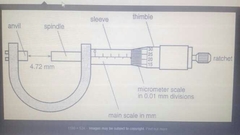![]()
![]()
![]()
Use LEFT and RIGHT arrow keys to navigate between flashcards;
Use UP and DOWN arrow keys to flip the card;
H to show hint;
A reads text to speech;
9 Cards in this Set
- Front
- Back
|
What does a vernier calliper look like?
How do you read a vernier calliper? Explain the steps. |

1) Where the zero reading on the small scale aligns with the big scale is the first value (to 1 d.p. since the precision of a cm vernier's caliper's big scale is 0.1 cm). Round down to the 1st 1 d.p. value, since the extra part in front of the last value will be found using the smaller scale.
E.g. in the image, zero reading is 1.1 cm since you round down to 1.1 cm because you are a bit in front of it.
2) The next value where the small scale aligns with the big one is the next decimal place value. (In this case, the 0.01 value). The value on the small scale is the 0.01 value.
E.g. in the image, the small scale aligns with the big scale at 6.5. so the 0.01 value is 0.065.
3) add the big scale value and small scale value together.
E.g. 1.1 + 0.065 = 1.165cm. NOTE: a Vernier Calliper might not be in cm, but the same rules can still be applied. |
|
|
What does a micrometer screw gauge look like? (Don't necessarily need to know the different parts of a micrometer)
How do you read a micrometer screw gauge? Explain the steps. |

1) The main (horizontal) scale goes up in intervals of 0.5. 2) The last fully visible value on the horizontal scale that isnt covered by the thimble AT ALL (the part with the horizontal scale on it) is the first value to 1 d.p. ( Since the intervals go up in 0.5, the 1st value will end in either .0 or .5) 3) Where the horizontal line on the horizontal scale aligns with the vertical scale is the 2nd value to 2 d.p. (vertical scale's smallest value is 0.01 and goes up in 0.01). E.g. 20 on the vertical scale = 0.2mm since 0.01 x 20 = 0.2 4) Add the 1st and 2nd value together. Done! |
|
|
Uncertainties are used in physics when values are recorded. If you only record one reading using an instrument, what is the uncertainty of that reading? |
Uncertainty is the precision of the instrument (uncertainty is the smallest possible reading that the instrument can record) |
|
|
If you record multiple readings for the same thing using an instrument, what is the uncertainty for the average of that reading? |
Uncertainty = range ÷ 2 |
|
|
How do you find percentage uncertainty of a value? |
(Uncertainty/actual value) x 100 |
|
|
Uncertainties are used in calculations. If 2 variables are being multiplied, what is the % uncertainty of the result? |
% uncertainty of result = % uncertainty of the two variables added. |
|
|
If a variable is being squared, what is the percentage uncertainty of the result? (If you already know the percentage uncertainty of the variable)? |
% uncertainty of variable squared (²) = % uncertainty of variable x 2
(Think of it like % uncertainty of variable x variable = % unc of variable + % unc of variable) |
|
|
If 2 variables are being added, how can you find the ABSOLUTE UNCERTAINTY (Actual value of the uncertainty) of the result? |
Find the absolute uncertainties of the variables individually then add the absolute uncertainties together. |
|
|
How do you find the absolute uncertainty of a single value using the value's percentage uncertainty? |
Absolute uncertainty of value = % uncertainty of value x value |

